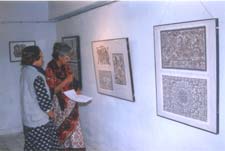Exhibition Of Mithila Paintings By Shakuntala Devi

Exhibition Of Mithila Paintings By Shakuntala Devi is an event that took place between 22-Nov-2001 and 30-Nov-2001 in Hyderabad.
-
Venue
-
Date/Time
-
Type
-
Price
-
Add New Field:
When you know that the Madhubani way of art is taught at the Rishi Valley School near Madanapalli in the Chitoor district of Andhra Pradesh, you can imagine how receptive and far reaching this traditional art of Mithila has gotten over the years. Originating from the mud walls in the remote villages of Bihar, it is in fact becoming a fashion statement, besides being treated as in league with the contemporary arts - for example, the well-known painter Arpana Caur has utilized the Madhubani form of art in her works to the optimum since over the last three years.
Spreading it to our stretches is none other than master craftswoman Shakuntala Devi. A septuagenarian, she has, like some others of her ilk such as Sita Devi, Chandrika Devi and Chandrakala Devi, not just solicited praise for this exquisite craft in the country but has impressed the world as such with her handwork.
Applying indigenous colors and limiting them to just black and red, Shakuntala maintains the purity of the medium, which basically has a single color of black applied on the mud walls as a votive form by the rural women. The limited number of works on display, on paper and textile (tusser and cotton to be precise), at the Minaz Art Gallery demonstrates not only the laboriousness of this medium but also the fine detailing incorporated in the mythical and mundane themes of village life. The Dasavatara to the Sita Swayamvaram, and the Geeta Upadesh to the Khobar Ghar (the design of the nuptial chamber) and the Mithala motifs on greeting cards is a fascinating range.
A brief lowdown on the craft itself: the craftspeople of Madhubani create their own dyes from natural elements and use bamboo sticks wrapped in cotton for painting. The act of painting itself is a communal practice where women of the family get together to paint the walls, which the folk then turn to pray to as their daily ritual. The patterns are usually preserved, and care is taken to see each succeeding generation of girls continues with the art. This may be one reason why each community still preserves its own distinctive style.
The paintings are very symbolic, illustrating the epics and common beliefs. The art of Madhubani is basically mythology. It is interesting to note that the votive form today finds place in the mercurial realms of design and fashion. Obviously it is the highly intricate patterning of the drawing itself that compels designers to offer significance to this art. And hence the renderers of this form are able to explore more besides the limited canvas of the walls - the scopes of paper, textiles and other mediums, too.
But while the craft and the craftspeople flourish, one also should keep in mind that the essence of the votive form is gradually transgressed as it becomes an applied art.
AA
Be the first to comment on Exhibition Of Mithila Paintings By Shakuntala Devi! Just use the simple form below.
LEAVE A COMMENT
fullhyd.com has 700,000+ monthly visits. Tell Hyderabad what you feel about Exhibition Of Mithila Paintings By Shakuntala Devi!
MORE EVENTS IN THIS PERIOD
ALL EVENT CATEGORIES
SEARCH EVENTS
Dissatisfied with the results? Report a problem or error, or add a listing.
ADVERTISEMENT
SHOUTBOX!
{{ todo.summary }}... expand »
{{ todo.text }}
« collapse
First | Prev |
1 2 3
{{current_page-1}} {{current_page}} {{current_page+1}}
{{last_page-2}} {{last_page-1}} {{last_page}}
| Next | Last
{{todos[0].name}}
{{todos[0].text}}
ADVERTISEMENT
This page was tagged for
mithilanchal Devi video gana
kobar ghar design
mithila kobar
geetaupadesh drawings
madhubani painting exhibition hyderabad